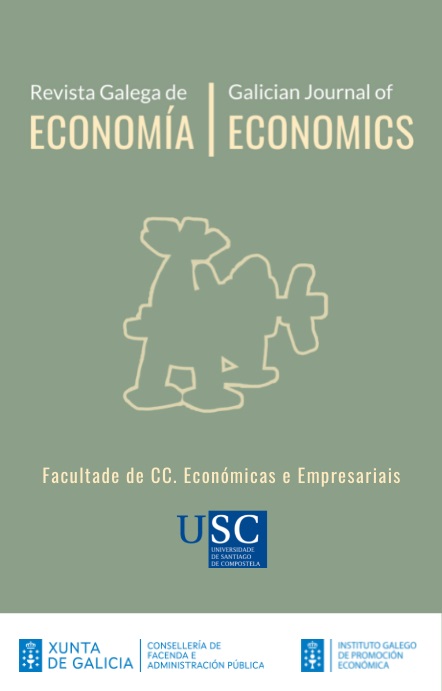Determinantes e cambios temporais no reparto das rendas turísticas entre orixe e destino. Evidencia das Illas Canarias
Contido principal do artigo
Resumo
Palabras chave
Detalles do artigo
Citas
Aguiló, E., e Juaneda, C. (2000). Tourist expenditure for mass tourism markets. Annals of Tourism Research, 7(3), 624-637. DOI: https://doi.org/10.1016/s0160-7383(99)00101-2
Alegre, J., Cladera, M., e Sard, M. (2011). Analysing the influence on tourist expenditure at a sun-and-sand destination. Tourism Economics, 17(4), 813-832. DOI: https://doi.org/10.5367/te.2011.0063
Alegre, J., Pou, L. (2008). Research note: Tourism expenditure and all-inclusive packages – The case of a mature mediterranean destination. Tourism Economics, 14(3), 645-655. DOI: https://doi.org/10.5367/000000008785633631
Basu, A., e Manca, A., (2012). Regression estimators for generic health-related quality of life and quality-adjusted life years. Medical Decision Making, 32(1), 56-69. DOI: https://doi.org/10.1177/0272989X11416988
Brida, J., e Scuderi, R. (2013). Tourism management perspectives. Tourism Management Perspectives, 6, 28-40. DOI: https://doi.org/10.1016/j.tmp.2012.10.006
Castellani, M., Pattitoni, P., e Scorcu, A., (2012). Visual artist price heterogeneity, Economics and Business Letters, 1(3), 16-22. DOI: https://doi.org/10.17811/ebl.1.3.2012.16-22
Castillo, E., Martínez, F., e Vázquez, E. (2015). O turismo en Ecuador. Novas tendencias no turismo sostible e contribución ao crecemento económico. Revista Galega de Economía, 24(2), pp. 69-84. Recuperado de http://www.usc.es/revistas/index.php/rge/article/view/2931
David-Negre, T., Hernández, J., e Moreno-Gil, S. (2018). Understanding tourists leisure expenditure at the destination: A social network analysis. Journal of Travel & Tourism Marketing, 35(7), 922-937. DOI: https://doi.org/10.1080/10548408.2018.1447533
Eurostat. (2018). Tourism statistics at regional level. Luxembourg, Luxembourg: Eurostat. Recuperado de https://ec.europa.eu/eurostat/statistics-explained/index.php/Tourism_statistics_at_regional_level
Exceltur. (2018). Impactur 2017. Estudio del impacto económico del turismo sobre la economía y el empleo de las Islas Canarias. Santa Cruz de Tenerife/Las Palmas de Gran Canaria: Gobierno de Canarias. Recuperado de https://www.exceltur.org/wp-content/uploads/2018/07/IMPACTUR-Canarias-2017.pdf
Ferrari, S., e Cribari-Neto, F. (2004). Beta regression for modelling rates and proportions, Journal of Applied Statistics, 31(7), 799-815. DOI: https://doi.org/10.1080/0266476042000214501
García, A., Artal, A., e Ramos, J.M. (2002). El turismo del Mar Menor: predominio de la segunda residencia. Cuadernos de Turismo, 9, 33-45. Recuperado de https://revistas.um.es/turismo/article/view/21981
Guisán, M.C. (2017). Desarrollo económico regional de España, 1986-2013. 25 años de evolución. Revista Galega de Economía, 26(2), 171-182. Recuperado de http://www.usc.es/revistas/index.php/rge/issue/view/332
Hviid, M., e Villadsen, B. (1995). Beta distributed market shares in a spatial model with an application to the market for audit services. Review of Industrial Organization, 10(6), 737-747.
ISTAC (varios anos): Encuesta sobre el gasto turístico. Las Palmas de Gran Canaria/Santa Cruz de Tenerife: Instituto Canario de Estadística.
Kastenholz, E. (2005). Analysing determinants of visitor spending for the rural tourist market in North Portugal. Tourism Economics, 11(4), 555-569. DOI: https://doi.org/10.5367/000000005775108728
Kieschnich, R., e MCCullough, B. D. (2003). Regresion analysis of variates observed on (0,1): percentages, proportions and fractions. Statistical Modelling, 3, 193-213. https://doi.org/10.1191/1471082X03st053oa
Man, R., e Liping, A. (2004). Information search behavior and tourist characteristics. Journal of Travel & Tourism Marketing, 17(2-3), 15-25.
Mok, C., e Iverson, J. (2000). Expenditure-Based segmentation: Taiwanese tourist to Guam. Tourism Management, 21(3), 299-305. DOI: https://doi.org/10.1016/s0261-5177(99)00060-6
Organización Mundial del Turismo. (2018): Why tourism? Tourism – An economic and social phenomenon. Madrid: Organización Mundial del Turismo.
Rodríguez, S., Dávila, C., Rodríguez, A., e Tejera, M. (2017). Factores asociados a los nuevos canales de compra del vuelo de turismo de sol y playa relacionados con TIC. Revista de Análisis Turístico, 24(2), 41-53. DOI: https://doi.org/10.1234/RAT2011n11
Sainaghi, R. (2012). Tourist expenditures: The state of the art. Anatolia, 23(2), 217-233. https://doi.org/10.1080/13032917.2012.684217
Salinas-Rodríguez, A., Pérez-Nuñez, R., e Ávila-Burgos, M., (2006). Modelos de regresión para variables expresadas como una proporción continua. Salud Pública de México, 48(5), 395-404. Recuperado de https://www.medigraphic.com/cgi-bin/new/resumen.cgi?IDARTICULO=12644
Smithson, M., e Verkuilen, J., (2006). A better lemon squeezer? Maximum-likelihood regression with betadistributed dependent variables. Psychological Methods, 11(1), 54-71. DOI: http://dx.doi.org/10.1037/1082-989X.11.1.54
Tyrrell, T., e Johnston, R. (2001). A framework for assessing direct economic impacts of tourist events: Distinguishing origins, destinations, and causes of expenditures. Journal of Travel Research, 40(1), 94-100. DOI: https://doi.org/10.1177/004728750104000112
Wang, Y., e Davidson, M. (2010). A review of micro-analyses of tourist expenditure. Current Issues in Tourism, 13(6), 507-524. https://doi.org/10.1080/13683500903406359






